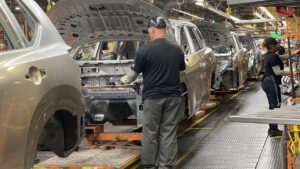Unpacking the Impact of 25% Tariffs on North America’s Automotive Industry
Introduction
The automotive landscape in North America is undergoing a seismic shift, largely driven by the recent 25% tariffs on imports from Mexico and Canada implemented by the Trump administration. This move has sent shockwaves through the industry, threatening to cut vehicle production by a staggering one-third, or around 20,000 units per day. At Extreme Investor Network, we aim to provide you with the in-depth analysis and insights that matter most, so you can stay ahead of these industry developments.
The Immediate Aftermath: A Glimpse into Production Levels
The tariffs, while intended as a measure to level trade disparities, have raised serious concerns about their real-world impact on automakers. According to S&P Global Mobility, the daily production of light-duty passenger vehicles in North America averages around 63,900 units, with approximately 65% coming from U.S. plants. The implications of these tariffs are not uniform; they will vary by automaker, vehicle model, and plant location. Stephanie Brinley, associate director of AutoIntelligence at S&P Global Mobility, suggested we may see shifts in plant operations, from reduced shifts to complete idling in some facilities.
Understanding the Cost-Benefit Equation
The auto industry is famously complex, with vehicles typically containing about 20,000 unique parts sourced from anywhere between 50 and 120 countries. This heavy reliance on cross-border supply chains complicates the equation significantly. Take the Ford F-150, for example: while it is assembled exclusively in the U.S., its production hinges on parts from at least 24 different countries. The new tariffs will undeniably raise costs, as manufacturers grapple with the economic strain of sourcing these parts.
The Alliance for Automotive Innovation has warned that all automakers will feel the impact, predicting vehicle prices may spike by as much as 25%. Such a dramatic increase could lead to reduced consumer demand, further jeopardizing an already challenged market.
Will Consumers Bear the Brunt?
The clear concern is whether manufacturers will pass on the cost increases to consumers. Several industry stakeholders, including the American Automotive Policy Council (AAPC), have argued that automakers who have invested heavily to meet stringent domestic content requirements under the USMCA should be exempt from these tariffs. Former Missouri Governor Matt Blunt, speaking on behalf of the AAPC, emphasized that increased costs would undermine U.S. competitiveness in an increasingly globalized market.
Furthermore, experts are already seeing the ripple effects on stock prices for automakers, which are falling faster than the broader market. As vehicle costs rise, the post-pandemic recovery of auto sales could be further hindered.
The Bigger Picture: A Chaotic Path Ahead?
While Trump and his administration may see tariffs as tools for renegotiating trade agreements to benefit American workers, many industry leaders view these measures as a source of chaos rather than strength. Ford CEO Jim Farley noted that the industry is experiencing significant disruptions, challenging the narrative that these tariffs will fortify American manufacturing.
The uncertainty surrounding the situation is palpable, especially as automakers navigate the complex web of parts and supply chains. The COVID-19 pandemic already strained the industry, leaving many companies more agile yet still highly vulnerable to sudden policy changes.
Conclusion: Stay Informed, Stay Prepared
At Extreme Investor Network, we aim to provide our readers with the thorough analysis and insights necessary to navigate the ever-changing landscape of the automotive industry. The introduction of these tariffs could mark a new chapter for North America’s automotive manufacturers—one that requires keen attention and strategic foresight. Keep an eye on our blog for ongoing updates and expert insights into how these developments will shape the future of vehicle production and pricing.
As always, we encourage you to remain engaged and informed as these situations unfold, and remember, the best investment strategy is one based on knowledge and awareness. Stay tuned for more exclusive insights from Extreme Investor Network!

